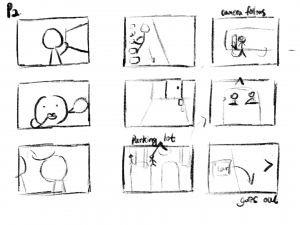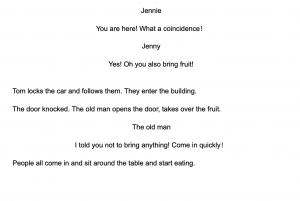Assignment 5.2
1> In what ways do you hope your screenings/exhibited/screened work (whether individual or group produced) engaged its audience and communicated a key concern of the studio?
In our studio, we are doing our own research project and decided our own research topic that we interest in, therefore it’s a more personal project. For my project, i think it will be good to do a video loop, doing a separate screen and put my final video and the Godfather baptism scene playing together. Therefore, the audience come in can have a better idea about the connection between two videos.
2> Imagine you are going to keep working on that media piece (e.g. to screen it somewhere else like a festival, or develop it into a different kind of work, and so on) – what would be the core things you would want to improve and extend and why?
If I’m going to keep working on my media piece, I want to make it as a work experience share or educate video. I’m going to borrow a camera and lights to redo the shooting, and record the shooting and editing process. Then edit them together with my voiceover explaining what I’m doing and why I’m doing this, and finally shows the final video. The aim is to give the people who want to do similar video or who are interested in making video but don’t know where to start some new ideas. Also, this is the first video I’ve done so I think it’s worth to record it as a good experience.
3> From your studio, reflect on an aspect of two other students/group’s media work on the website in terms of specific insights they produced about a key idea addressed by the studio?
Xinyu’s report is reflecting on how Chungking Express shapes the style of Wong Kai-wai. Wong is definitely an auteur, he has a continuity distinctive style in his film career. All of his film is actually talking one story over and over, that is to reflect the struggle of lonely individuals in urban life. Also, time and memory are the everlasting theme in Wong’s movie. As Xinyu mentioned, the memory and flow of time are broken and free, traversing countless ambiguous clips. It can be reflect through the two stories in Chungking Express, Cop223 and 663. Wong’s stylistic visual can never ignore the contribution of his cinematographer Christopher Doyle’s contribution. Xinyu also describe how the camera works, which I don’t know before. This blurred visual also identify the loneliness feeling of the character and might also can be understand that we are in character’s psychological level. Furthermore, the music, light, style over narrative style as an important part of forming Wong’s distinctive style. In Yuechen’s report, she analysis Wong’s The Grandmaster from the camera work, the effect of this film and the aesthetic style. When I watching The Grandmaster, I think it supposed to be an action film, but still feel like watching a literary film, that’s Wong’s style, extreme romanticism, even with the fight scene. The slow motion and detail shot of rain and dust fall slowly brings aesthetic feeling to the fight. Yuechen also mentions that the special effects are used in The Grandmaster. I didn’t even noticed that! The snow is such realistic! However, it’s actually complete by CG setting, 3D transfer technology, 2D character image shape plat, which is a very complex process.
4> For the other studio website you engaged with, describe a key idea that you think the finished media/studio work communicated with reference to a specific example (i.e. a particular individual/group work)
I engaged with the studio of It’s Not Rocket Surgery, their final assignment is to study a complex concept for a particular audience. What impress me the most is Joel’s group’s video, the video explore the concept of “history” and tend to educate the students or people who are interested in or learning the history. The video points out that the history itself is unreliable, mainly because it’s hard for people to view things completely objective, people who writes it may carry their own perspective, tones, languages, experience, feeling, etc, thus, make the historical fact unreal. The history also could be rewrite by the winner of the war. Therefore, we can carry critical thinking to look at the history, and view it as a puzzle pieces rather than full picture. I think it’s a wonderful piece as an educate video for both children and adult. I love the presented style of the video, it’s really well made. The little people look like cut from the paper piece, also with the squares. I’m not sure if the video is made up by stop-motion animation. If it is, I think it’s a big process. I also like the way how text works, the text add relaxed and lively feeling to the video. Further to mention is the sound effect, it’s the finishing touch that makes the video complete. All in all, I think this video perfect done its function of educating people who what to know about the history and give them another way to look at it.
Thank you very much!










